The Development of Decarbonisation Strategies: A Three-Step Methodology for the Suitable Analysis of Current EVCS Locations Applied to Istanbul, Turkey
Abstract
1. Introduction
- Drivers will benefit from convenient and timely charging, and decreasing waiting time;
- Optimal location of the charging station will also result in lower charging costs;
- The operators of the charging points will achieve higher and more predictable use of their resources and lower network connection costs;
- Investors receive higher returns on their investments and reduced risk;
- Distribution system operators will have a better prediction of the likely distribution of charging infrastructure on their system and the resulting load, allowing them to improve their network investments;
- Utilities/aggregators will be able to offer more valuable services to their customers and the network if more vehicles are connected more often;
- Car manufacturers will also have a better forecast of the likely distribution of chargers and will have more satisfied EV customers and optimal e-mobility related services leading to more EV sales.
2. Literature and Methodological Review
- Availability of charging points other than home charging on private and public land (public and company car parks, supermarkets, railway stations, traditional service stations that have also been converted to electric mobility) with the possibility of slow and fast charging;
- Availability of multistandard charging systems open to different suppliers;
- Encouraging actions by local authorities (free parking, exemption from road pricing systems, use of reserved lanes);
- State encouragement (economic incentives, tax exemptions).
3. Materials
- GIS-based MCDA approach was proposed to determine the performance values of current EVCSs. Thus, the lack/need of spatial analysis in the studies in the literature was eliminated.
- When previous studies are examined, it is observed that the evaluation criteria are limited. However, the locations of EVCS in charging service are directly related to multiple factors such as energy, environment, transportation, economic and geographic. A comprehensive criterion pool was created for being the correct of EVCSs’ performance evaluation in this paper.
- As the novelty of the study, the current infrastructure of electric vehicles, which is the most popular transportation application, is examined both sectorially and scientifically.
- The number of stations considered in earlier studies is quite low. This situation indicates that the study area is not analysed completely, and the station analyses are not valid. Therefore, the accuracy and validity of the performance evaluation of all EVCSs (including individual EVCSs) were provided by analysing the metropolitan city such as Istanbul as a whole.
- The biggest obstacle to the dissemination of EVs is undoubtedly the charging infrastructure. By examining the suitability map, it can be ensured that current stations are used effectively with the relocation of the stations in unsuitable areas to the most suitable areas.
- This study is a guideline for current and potential service providers with the determination of the most suitable areas for EVCS locations.
- Suitable areas will be classified among themselves in the suitability map. Thus, being testable of the station evaluation will be ensured.
3.1. Study Area
3.2. Some Considerations on the Economics of Recharging Electric Vehicles in Turkey
- Charging stations—Charging station infrastructure is not disseminated throughout the country;
- Legislation—There is no needed legislation on the use of EVs in Turkey and there is still more uncertainty on this issue;
- Taxes—Taxes on vehicles are quite high in Turkey. Although there is a tax incentive in EVs, the purchase cost is still not at acceptable levels;
- Promotion—Potential users are not provided with enough information about EVs.
3.3. Definition of Criteria
4. Methods
4.1. Analytical Hierarchy Process (AHP)
4.2. Geographical Information Systems (GIS)
4.3. Technique for Order Preference by Similarity to an Ideal Solution (TOPSIS)
5. Results
5.1. Analysis of AHP
5.2. Analysis of GIS
5.3. Analysis of TOPSIS
5.4. Sensitivity Analysis
6. Discussion
7. Conclusions
Author Contributions
Funding
Acknowledgments
Conflicts of Interest
References
- U.S. Energy Information Administration. International Energy Outlook 2016. Available online: https://www.eia.gov/outlooks/ieo/pdf/0484(2016).pdf (accessed on 15 March 2021).
- U.S. Energy Information Administration. Monthly Energy Review. April 2021. Available online: https://www.eia.gov/totalenergy/data/monthly/pdf/mer.pdf (accessed on 15 March 2021).
- Ritchie, H.; Roser, M. CO2 and Other Greenhouse Gas Emissions. Available online: https://ourworldindata.org/co2-and-other-greenhouse-gas-emissions (accessed on 14 March 2021).
- Tiseo, I. Global distribution of CO2 emissions from fossil fuel and cement by sector 2020. Sci. Data 2021, 7, 1–12. [Google Scholar]
- U.S. Energy Information Administration. International Energy Outlook 2019. Available online: https://www.eia.gov/outlooks/ieo/pdf/ieo2019.pdf (accessed on 15 March 2021).
- McGinn, A.; Isenhour, C. Negotiating the future of the Adaptation Fund: On the politics of defining and defending justice in the post-Paris Agreement period. Clim. Policy 2021, 1–3. [Google Scholar] [CrossRef]
- Michaelowa, A.; Michaelowa, K.; Shishlov, I.; Brescia, D. Catalysing private and public action for climate change mitigation: The World Bank’s role in international carbon markets. Clim. Policy 2020, 1–13. [Google Scholar] [CrossRef]
- European Commission the European Green Deal. Eur. Comm. 2019, 53, 24. [CrossRef]
- Johnston, R.B. Arsenic and the 2030 Agenda for sustainable development. Arsen. Res. Glob. Sustain. As 2016, 12–14. [Google Scholar] [CrossRef]
- Madziel, M.; Campisi, T.; Jaworski, A.; Teseoriere, G. The Development of Strategies to Reduce Exhaust Emissions from Passenger Cars in Rzeszow City—Poland A Preliminary Assessment of the Results Produced by the Increase of E-Fleet. Energies 2021, 14, 1046. [Google Scholar]
- Teseoriere, G.; Campisi, T. The Benefit of Engage the “Crowd” Encouraging a Bottom-up Approach for Shared Mobility Rating. In Proceedings of the International Conference on Computational Science and Its Applications, Cagliari, Italy, 1–4 July 2020; Springer: Cham, Switzerland, 2020; pp. 836–850. [Google Scholar]
- Karjalainen, L.E.; Juhola, S. Urban transportation sustainability assessments: A systematic review of literature. Transp. Rev. 2021, 1–26. [Google Scholar] [CrossRef]
- Torrisi, V.; Ignaccolo, M.; Inturri, G.; Tesoriere, G.; Campisi, T. Exploring the factors affecting bike-sharing demand: Evidence from student perceptions, usage patterns and adoption barriers. Transp. Res. Procedia 2021, 52, 573–580. [Google Scholar] [CrossRef]
- Campisi, T.; Basbas, S.; Skoufas, A.; Akgün, N.; Ticali, D.; Tesoriere, G. The Impact of COVID-19 Pandemic on the Resilience of Sustainable Mobility in Sicily. Sustainability 2020, 12, 8829. [Google Scholar] [CrossRef]
- Moraci, F.; Errigo, M.F.; Fazia, C.; Campisi, T.; Castelli, F. Cities under pressure: Strategies and tools to face climate change and pandemic. Sustainability 2020, 12, 7743. [Google Scholar] [CrossRef]
- Saygın, D.; Bülent Tör, O.; Teimourzadeh, S.; Koç, M.; Hildermeier, J.; Kolokathis, C. Transport Sector Transformation: Integrating Electric Vehicles into Turkey’s Distribution Grids. SHURA Istanbul. 2019. Available online: https://www.shura.org.tr/wp-content/uploads/2019/12/Transport-sector-transformation.Integrating-electric-vehicles-into-Turkey%E2%80%99s-distribution-grids.pdf (accessed on 18 March 2021).
- Hong, I.; Kuby, M.; Murray, A.T. A range-restricted recharging station coverage model for drone delivery service planning. Transp. Res. Part. C Emerg. Technol. 2018, 90, 198–212. [Google Scholar] [CrossRef]
- Huang, H.; Savkin, A.V. A Method of Optimized Deployment of Charging Stations for Drone Delivery. IEEE Trans. Transp. Electrif. 2020, 6, 510–518. [Google Scholar] [CrossRef]
- Erbaş, M.; Kabak, M.; Özceylan, E.; Çetinkaya, C. Optimal siting of electric vehicle charging stations: A GIS-based fuzzy Multi-Criteria Decision Analysis. Energy 2018, 163, 1017–1031. [Google Scholar] [CrossRef]
- Istanbul Metropolitan Municipality Istanbul Transport Annual Report. Available online: https://tuhim.ibb.gov.tr/en/statistical-information/ (accessed on 18 October 2020).
- Feng, J.; Xu, S.X.; Li, M. A novel multi-criteria decision-making method for selecting the site of an electric-vehicle charging station from a sustainable perspective. Sustain. Cities Soc. 2021, 65, 102623. [Google Scholar] [CrossRef]
- Wu, Y.; Xie, C.; Xu, C.; Li, F. A decision framework for electric vehicle charging station site selection for residential communities under an intuitionistic fuzzy environment: A case of Beijing. Energies 2017, 10, 1270. [Google Scholar] [CrossRef]
- Gan, X.; Zhang, H.; Hang, G.; Qin, Z.; Jin, H. Fast-Charging Station Deployment Considering Elastic Demand. IEEE Trans. Transp. Electrif. 2020, 6, 158–169. [Google Scholar] [CrossRef]
- Kabak, M.; Erbaş, M.; Çetinkaya, C.; Özceylan, E. A GIS-based MCDM approach for the evaluation of bike-share stations. J. Clean. Prod. 2018, 201, 49–60. [Google Scholar] [CrossRef]
- Lin, M.; Huang, C.; Xu, Z. MULTIMOORA based MCDM model for site selection of car sharing station under picture fuzzy environment. Sustain. Cities Soc. 2020, 53, 101873. [Google Scholar] [CrossRef]
- Wu, Y.; Yang, M.; Zhang, H.; Chen, K.; Wang, Y. Optimal site selection of electric vehicle charging stations based on a cloud model and the PROMETHEE method. Energies 2016, 9, 157. [Google Scholar] [CrossRef]
- Xu, J.; Zhong, L.; Yao, L.; Wu, Z. An interval type-2 fuzzy analysis towards electric vehicle charging station allocation from a sustainable perspective. Sustain. Cities Soc. 2018, 40, 335–351. [Google Scholar] [CrossRef]
- Jordán, J.; Palanca, J.; del Val, E.; Julian, V.; Botti, V. Using Genetic Algorithms to Optimize the Location of Electric Vehicle Charging Stations. In Proceedings of the 13th International Conference on Soft Computing Models in Industrial and Environmental Applications, Seville, Spain, 13–15 May 2019; Springer International Publishing: Cham, Switzerland, 2019. [Google Scholar]
- Zhao, H.; Li, N. Optimal siting of charging stations for electric vehicles based on fuzzy Delphi and hybrid multi-criteria decision making approaches from an extended sustainability perspective. Energies 2016, 9, 270. [Google Scholar] [CrossRef]
- Zhang, S.; Wang, H.; Zhang, Y.; Li, Y.-Z. A novel two-stage location model of charging station considering dynamic distribution of electric taxis. Sustain. Cities Soc. 2019, 51, 101752. [Google Scholar] [CrossRef]
- Wang, W.; Zhang, Q.; Peng, Z.; Shao, Z.; Li, X. An empirical evaluation of different usage pattern between car-sharing battery electric vehicles and private ones. Transp. Res. Part. A Policy Pract. 2020, 135, 115–129. [Google Scholar] [CrossRef]
- Ju, Y.; Ju, D.; Santibanez Gonzalez, E.D.R.; Giannakis, M.; Wang, A. Study of site selection of electric vehicle charging station based on extended GRP method under picture fuzzy environment. Comput. Ind. Eng. 2019, 135, 1271–1285. [Google Scholar] [CrossRef]
- Ko, J.; Kim, D.; Nam, D.; Lee, T. Determining locations of charging stations for electric taxis using taxi operation data. Transp. Plan. Technol. 2017, 40, 420–433. [Google Scholar] [CrossRef]
- Guo, S.; Zhao, H. Optimal site selection of electric vehicle charging station by using fuzzy TOPSIS based on sustainability perspective. Appl. Energy 2015, 158, 390–402. [Google Scholar] [CrossRef]
- Hosseini, S.; Sarder, M.D. Development of a Bayesian network model for optimal site selection of electric vehicle charging station. Int. J. Electr. Power Energy Syst. 2019, 105, 110–112. [Google Scholar] [CrossRef]
- Shahraki, N.; Cai, H.; Turkay, M.; Xu, M. Optimal locations of electric public charging stations using real world vehicle travel patterns. Transp. Res. Part. D Transp. Environ. 2015, 41, 165–176. [Google Scholar] [CrossRef]
- Deveci, M.; Canıtez, F.; Gökaşar, I. WASPAS and TOPSIS based interval type-2 fuzzy MCDM method for a selection of a car sharing station. Sustain. Cities Soc. 2018, 41, 777–791. [Google Scholar] [CrossRef]
- Çalış Boyacı, A.; Şişman, A.; Sarıcaoğlu, K. Site selection for waste vegetable oil and waste battery collection boxes: A GIS-based hybrid hesitant fuzzy decision-making approach. Environ. Sci. Pollut. Res. 2021. [Google Scholar] [CrossRef]
- Haddad, B.; Díaz-Cuevas, P.; Ferreira, P.; Djebli, A.; Pérez, J.P. Mapping concentrated solar power site suitability in Algeria. Renew. Energy 2021, 168, 838–853. [Google Scholar] [CrossRef]
- Koop, A. Ranked: The Most Populous Cities in the World. Available online: https://www.visualcapitalist.com/most-populous-cities-in-the-world/ (accessed on 12 March 2021).
- Turkish Statistical Institute Number of Vehicles by Provinces. Available online: http://www.tuik.gov.tr/PreIstatistikTablo.do?istab_id=1581 (accessed on 14 March 2021).
- Istanbul Metropolitan Municipality Istanbul Climate Change Action Plan. 2018. Available online: https://www.iklim.istanbul/wp-content/uploads/%C3%96zetRapor%C4%B0ngilizce.pdf (accessed on 16 March 2021).
- Ağbulut, Ü.; Bakır, H. The Investigation on Economic and Ecological Impacts of Tendency to Electric Vehicles Instead of Internal Combustion Engines. Düzce Univ. J. Sci. Technol. 2019, 7, 25–36. [Google Scholar] [CrossRef]
- Compare the Market Cost of Charging an Electric Car Globally. Available online: https://www.comparethemarket.com/car-insurance/content/cost-of-charging-an-electric-car-globally/ (accessed on 16 March 2021).
- Harighi, T.; Padmanaban, S.; Bayindir, R.; Hossain, E.; Holm-Nielsen, J.B. Electric vehicle charge stations location analysis and determination—Ankara (Turkey) case study. Energies 2019, 12, 3472. [Google Scholar] [CrossRef]
- Statista Number of Electric Vehicle Charging Stations in Turkey by Type 2012–2019. Available online: https://www.statista.com/statistics/935960/number-of-electric-vehicle-charging-stations-turkey (accessed on 16 March 2021).
- Yalçın, D.; Arıkan, F. Electric Vehicle Regulation and Law in Turkey. Progr. Plann. 2000, 54, 199–278. [Google Scholar]
- Zhang, Q.; Li, H.; Zhu, L.; Campana, P.E.; Lu, H.; Wallin, F.; Sun, Q. Factors influencing the economics of public charging infrastructures for EV—A review. Renew. Sustain. Energy Rev. 2018, 94, 500–509. [Google Scholar] [CrossRef]
- Hardman, S.; Jenn, A.; Tal, G.; Axsen, J.; Beard, G.; Daina, N.; Figenbaum, E.; Jakobsson, N.; Jochem, P.; Kinnear, N. A review of consumer preferences of and interactions with electric vehicle charging infrastructure. Transp. Res. Part. D Transp. Environ. 2018, 62, 508–523. [Google Scholar] [CrossRef]
- Lin, X.; Sun, J.; Ai, S.; Xiong, X.; Wan, Y.; Yang, D. Distribution network planning integrating charging stations of electric vehicle with V2G. Int. J. Electr. Power Energy Syst. 2014, 63, 507–512. [Google Scholar] [CrossRef]
- Filote, C.; Felseghi, R.A.; Raboaca, M.S.; Aşchilean, I. Environmental impact assessment of green energy systems for power supply of electric vehicle charging station. Int. J. Energy Res. 2020, 44, 10471–10494. [Google Scholar] [CrossRef]
- Awasthi, A.; Venkitusamy, K.; Padmanaban, S.; Selvamuthukumaran, R.; Blaabjerg, F.; Singh, A.K. Optimal planning of electric vehicle charging station at the distribution system using hybrid optimization algorithm. Energy 2017, 133, 70–78. [Google Scholar] [CrossRef]
- Chen, T.D.; Kockelman, K.M.; Khan, M. Locating Electric Vehicle Charging Stations: Parking-Based Assignment Method for Seattle, Washington. Transp. Res. Rec. J. Transp. Res. Board 2013, 2385, 28–36. [Google Scholar] [CrossRef]
- Shi, R.; Zhang, J.; Su, H.; Liang, Z.; Lee, K.Y. An Economic Penalty Scheme for Optimal Parking Lot Utilization with EV Charging Requirements. Energies 2020, 13, 6155. [Google Scholar] [CrossRef]
- Kwag, S.I.; Hur, U.; Ko, Y.D. Sustainable electric personal mobility: The design of a wireless charging infrastructure for urban tourism. Sustainability 2021, 13, 1270. [Google Scholar] [CrossRef]
- Ko, Y.D.; Song, B.D. Sustainable service design and revenue management for electric tour bus systems: Seoul city tour bus service and the eco-mileage program. J. Sustain. Tour. 2019, 27, 308–326. [Google Scholar] [CrossRef]
- Tu, W.; Li, Q.; Fang, Z.; Shaw, S.L.; Zhou, B.; Chang, X. Optimizing the locations of electric taxi charging stations: A spatial–temporal demand coverage approach. Transp. Res. Part. C Emerg. Technol. 2016, 65, 172–189. [Google Scholar] [CrossRef]
- Qu, Z.; Wang, X.; Song, X.; Pan, Z.; Li, H. Location Optimization for Urban Taxi Stands Based on Taxi GPS Trajectory Big Data. IEEE Access 2019, 7, 62273–62283. [Google Scholar] [CrossRef]
- Guler, D.; Yomralioglu, T. Suitable location selection for the electric vehicle fast charging station with AHP and fuzzy AHP methods using GIS. Ann. GIS 2020, 26, 169–189. [Google Scholar] [CrossRef]
- Raposo, J.; Rodrigues, A.; Silva, C.; Dentinho, T. A multi-criteria decision aid methodology to design electric vehicles public charging networks. AIP Adv. 2015, 5. [Google Scholar] [CrossRef]
- He, Y.; Zhou, X.; Liu, Z.; Ran, M. Layout optimization design of electric vehicle charging station based on urban parking lot. Lect. Notes Electr. Eng. 2018, 419, 399–407. [Google Scholar] [CrossRef]
- Saaty, T.L. A scaling method for priorities in hierarchical structures. J. Math. Psychol. 1977, 15, 234–281. [Google Scholar] [CrossRef]
- Saaty, T.L. The Analytic Hierarchy Process. In Içinde Encyclopedia of Biostatistics; McGraw-Hill: New York, NY, USA, 1980. [Google Scholar]
- Ge, Y.; Xiao, M.; Wang, X.; Zhang, L.; Wang, W.; Hou, X. AHP method research of decision-making information system in integrated test technology based on granular computing. In Proceedings of the 2015 IEEE International Conference on Signal Processing, Communications and Computing (ICSPCC), Ningbo, China, 19–22 September 2015. [Google Scholar]
- Moeinaddini, M.; Khorasani, N.; Danehkar, A.; Darvishsefat, A.A.; Zienalyan, M. Siting MSW landfill using weighted linear combination and analytical hierarchy process (AHP) methodology in GIS environment (case study: Karaj). Waste Manag. 2010, 30, 912–920. [Google Scholar] [CrossRef]
- Klein, L.L.; Tonetto, M.S.; Avila, L.V.; Moreira, R. Management of lean waste in a public higher education institution. J. Clean. Prod. 2021, 286, 125386. [Google Scholar] [CrossRef]
- Díaz-López, C.; Carpio, M.; Martín-Morales, M.; Zamorano, M. Defining strategies to adopt Level(s) for bringing buildings into the circular economy. A case study of Spain. J. Clean. Prod. 2021, 287. [Google Scholar] [CrossRef]
- Ramavandi, B.; Darabi, A.H.; Omidvar, M. Risk assessment of hot and humid environments through an integrated fuzzy AHP-VIKOR method. Stoch. Environ. Res. Risk Assess. 2021, 1. [Google Scholar] [CrossRef]
- Hartanto, B.W.; Mayasari, D.S. Environmentally friendly non-medical mask: An attempt to reduce the environmental impact from used masks during COVID 19 pandemic. Sci. Total Environ. 2021, 760, 144143. [Google Scholar] [CrossRef] [PubMed]
- Abdallah, M.; Hamdan, S.; Shabib, A. A multi-objective optimization model for strategic waste management master plans. J. Clean. Prod. 2021, 284, 124714. [Google Scholar] [CrossRef]
- Abdel-Basset, M.; Gamal, A.; Chakrabortty, R.K.; Ryan, M.J. Evaluation approach for sustainable renewable energy systems under uncertain environment: A case study. Renew. Energy 2021, 168, 1073–1095. [Google Scholar] [CrossRef]
- Koohathongsumrit, N.; Meethom, W. Route selection in multimodal transportation networks: A hybrid multiple criteria decision-making approach. J. Ind. Prod. Eng. 2021, 38, 171–185. [Google Scholar] [CrossRef]
- Kutlu Gündoğdu, F.; Duleba, S.; Moslem, S.; Aydın, S. Evaluating public transport service quality using picture fuzzy analytic hierarchy process and linear assignment model. Appl. Soft Comput. 2021, 100, 106920. [Google Scholar] [CrossRef]
- Şahin, T.; Ocak, S.; Top, M. Analytic hierarchy process for hospital site selection. Health Policy Technol. 2019, 8, 42–50. [Google Scholar] [CrossRef]
- Martindale, J. Mapping and Geographic Information Systems (GIS). Available online: https://researchguides.library.wisc.edu/prf.php?account_id=55066 (accessed on 18 September 2020).
- Marzouk, M.; Attia, K.; Azab, S. Assessment of Coastal Vulnerability to Climate Change Impacts using GIS and Remote Sensing: A Case Study of Al-Alamein New City. J. Clean. Prod. 2021, 290, 125723. [Google Scholar] [CrossRef]
- Pászto, V.; Burian, J.; Macků, K. Changing mobility lifestyle: A case study on the impact of COVID-19 using personal google locations data. Int. J. E Plan. Res. 2021, 10, 66–79. [Google Scholar] [CrossRef]
- Ramos-Escudero, A.; García-Cascales, M.S.; Cuevas, J.M.; Sanner, B.; Urchueguía, J.F. Spatial analysis of indicators affecting the exploitation of shallow geothermal energy at European scale. Renew. Energy 2021, 167, 266–281. [Google Scholar] [CrossRef]
- Tissen, C.; Menberg, K.; Benz, S.A.; Bayer, P.; Steiner, C.; Götzl, G.; Blum, P. Identifying key locations for shallow geothermal use in Vienna. Renew. Energy 2021, 167, 1–19. [Google Scholar] [CrossRef]
- Luan, C.; Liu, R.; Peng, S. Land-use suitability assessment for urban development using a GIS-based soft computing approach: A case study of Ili Valley, China. Ecol. Indic. 2021, 123, 107333. [Google Scholar] [CrossRef]
- Wubalem, A. Landslide Susceptibility Mapping using Statistical Methods in Uatzau Catchment Area, Northwestern Ethiopia. Geoenviron. Disasters 2020, 8, 1–21. [Google Scholar] [CrossRef]
- Li, J.; Pei, X.; Wang, X.; Yao, D.; Zhang, Y.; Yue, Y. Transportation mode identification with GPS trajectory data and GIS information. Tsinghua Sci. Technol. 2021, 26, 403–416. [Google Scholar] [CrossRef]
- Wang, T.C.; Chang, T.H. Application of TOPSIS in evaluating initial training aircraft under a fuzzy environment. Expert Syst. Appl. 2007, 33, 870–880. [Google Scholar] [CrossRef]
- Karaşan, A.; Kaya, İ.; Erdoğan, M. Location selection of electric vehicles charging stations by using a fuzzy MCDM method: A case study in Turkey. Neural Comput. Appl. 2018, 1–22. [Google Scholar] [CrossRef]
- Çetinkaya, C.; Özceylan, E.; Erbaş, M.; Kabak, M. GIS-based fuzzy MCDA approach for siting refugee camp: A case study for southeastern Turkey. Int. J. Disaster Risk Reduct. 2016, 18, 218–231. [Google Scholar] [CrossRef]
- Nyimbili, P.H.; Erden, T.; Karaman, H. Integration of GIS, AHP and TOPSIS for earthquake hazard analysis. Nat. Hazards 2018, 92, 1523–1546. [Google Scholar] [CrossRef]
- Muhsen, D.H.; Haider, H.T.; Al-Nidawi, Y.M.; Khatib, T. Domestic load management based on integration of MODE and AHP-TOPSIS decision making methods. Sustain. Cities Soc. 2019, 50, 101651. [Google Scholar] [CrossRef]
- Behzadian, M.; Khanmohammadi Otaghsara, S.; Yazdani, M.; Ignatius, J. A state-of the-art survey of TOPSIS applications. Expert Syst. Appl. 2012, 39, 13051–13069. [Google Scholar] [CrossRef]
- Chen, P. Effects of normalization on the entropy-based TOPSIS method. Expert Syst. Appl. 2019, 136, 33–41. [Google Scholar] [CrossRef]
- Awasthi, A.; Omrani, H.; Gerber, P. Investigating ideal-solution based multicriteria decision making techniques for sustainability evaluation of urban mobility projects. Transp. Res. Part. A Policy Pract. 2018, 116, 247–259. [Google Scholar] [CrossRef]
- Alonso, J.A.; Lamata, M.T. Consistency in the Analytic Hierarchy Process: A New Approach. Int. J. Uncertain. Fuzziness Knowl. Based Syst. 2006, 14, 445–459. [Google Scholar] [CrossRef]
- Withanage, G.P.; Gunawardana, M.; Viswakula, S.D.; Samaraweera, K.; Gunawardena, N.S.; Hapugoda, M.D. Multivariate spatio-temporal approach to identify vulnerable localities in dengue risk areas using Geographic Information System (GIS). Sci. Rep. 2021, 11, 4080. [Google Scholar] [CrossRef]
- Xie, Z.; Yan, J. Kernel Density Estimation of traffic accidents in a network space. Comput. Environ. Urban Syst. 2008, 32, 396–406. [Google Scholar] [CrossRef]
- Okabe, A.; Satoh, T.; Sugihara, K. A kernel density estimation method for networks, its computational method and a GIS-based tool. Int. J. Geogr. Inf. Sci. 2009, 23, 7–32. [Google Scholar] [CrossRef]
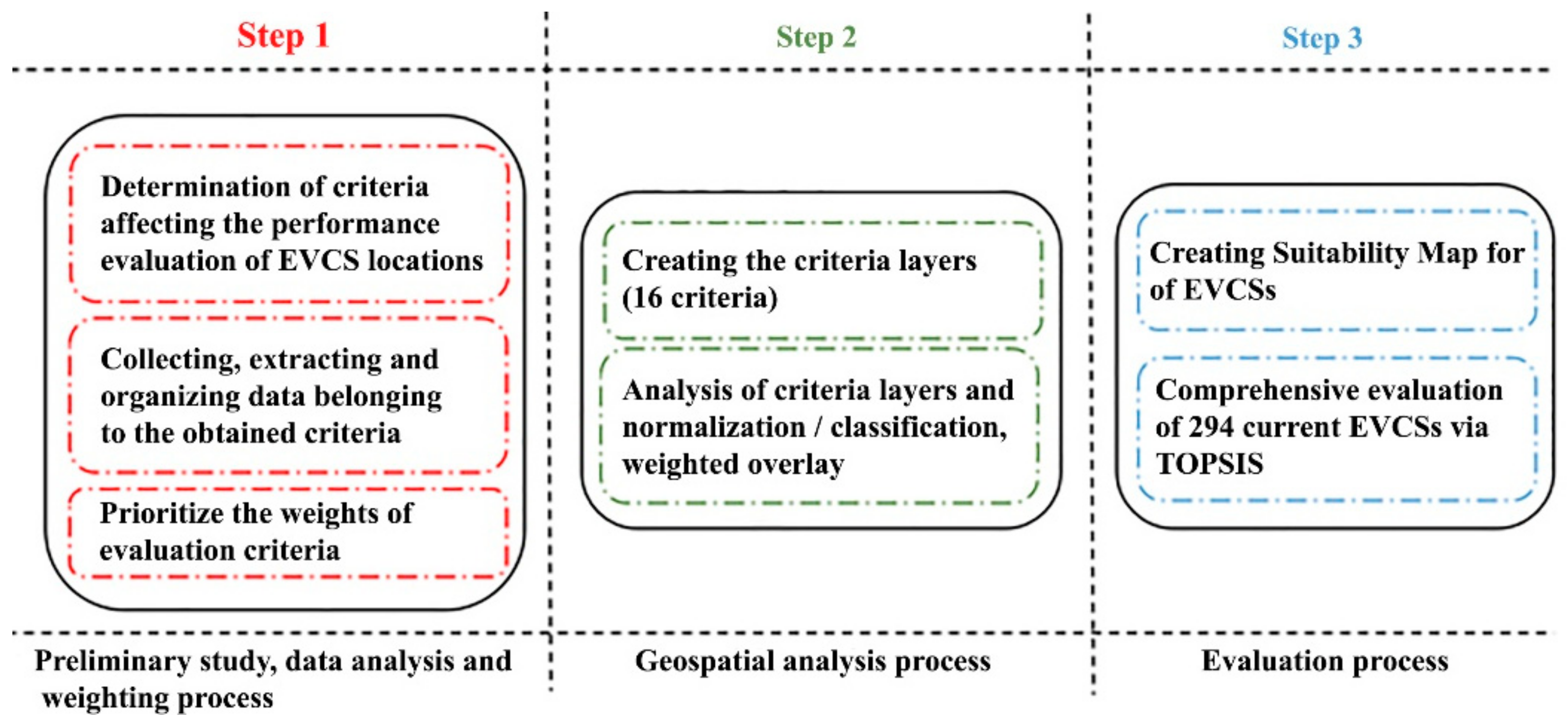

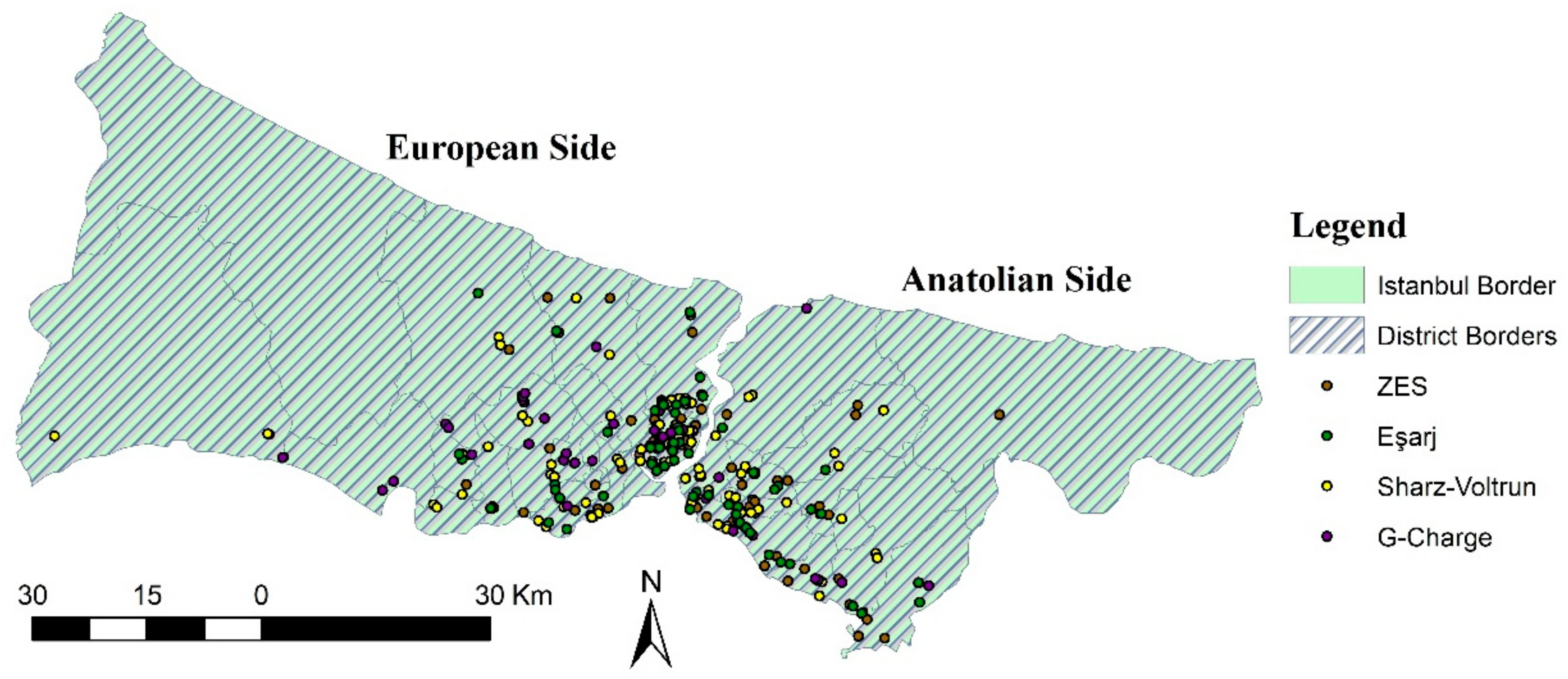
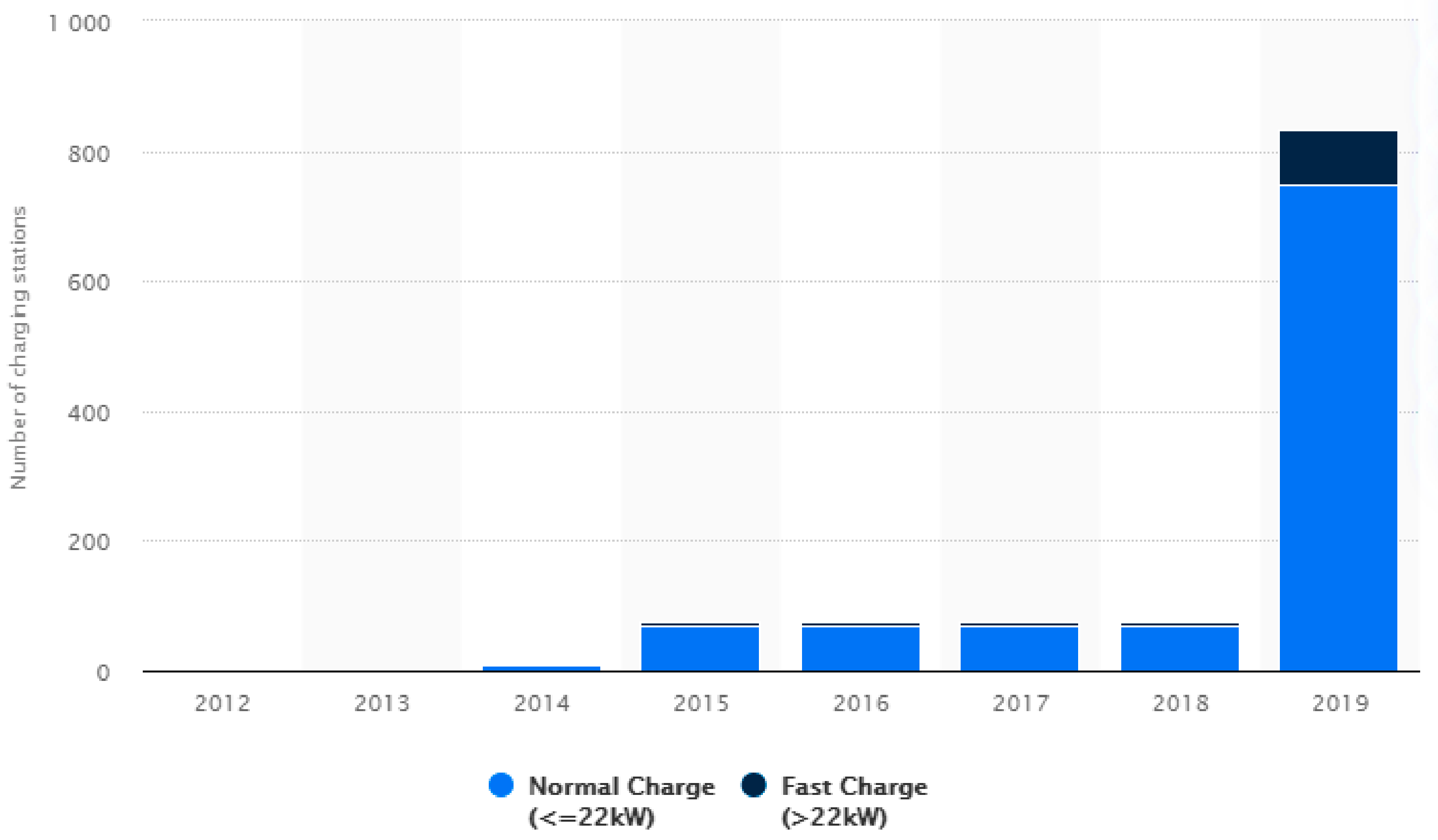

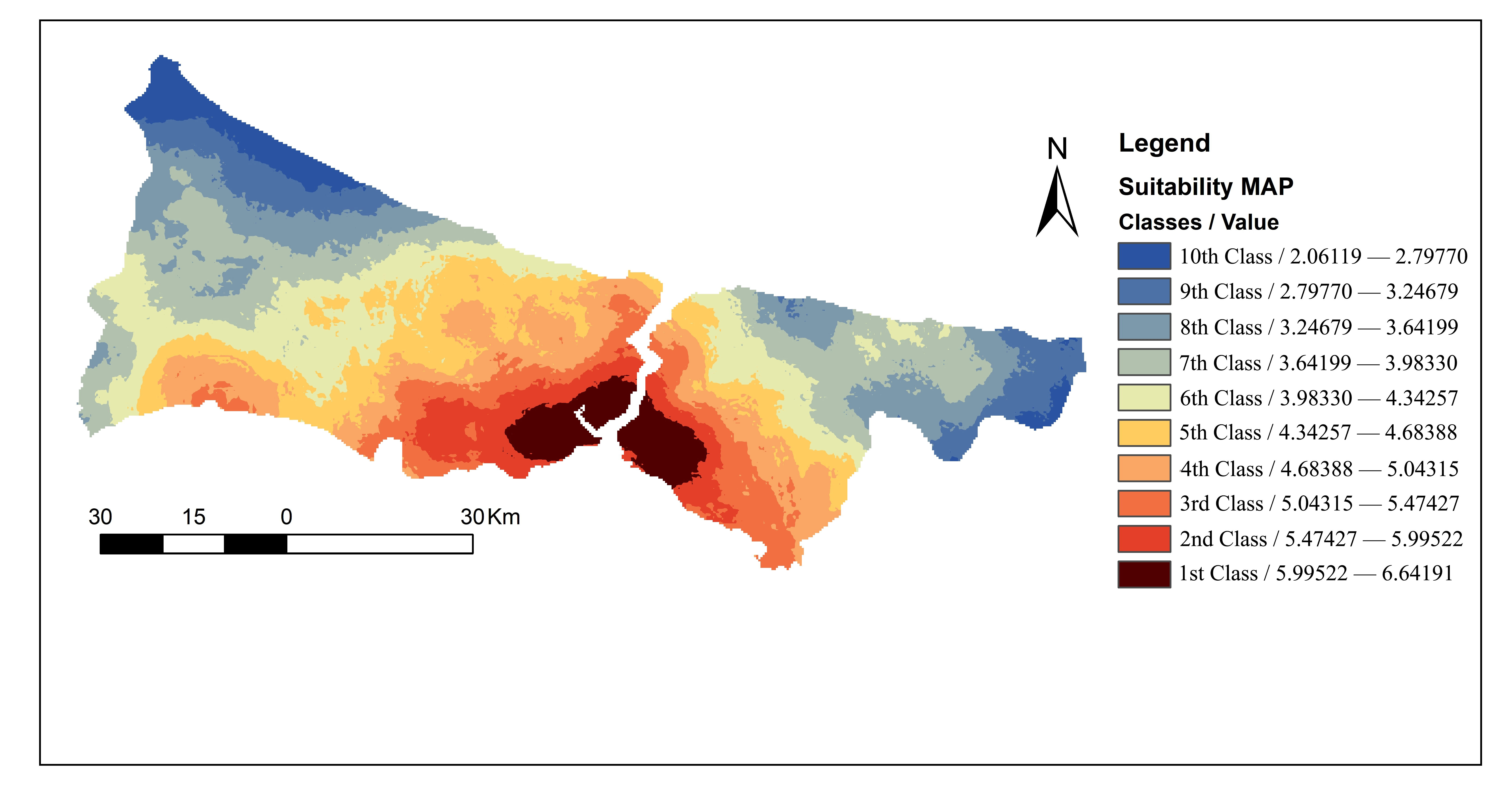
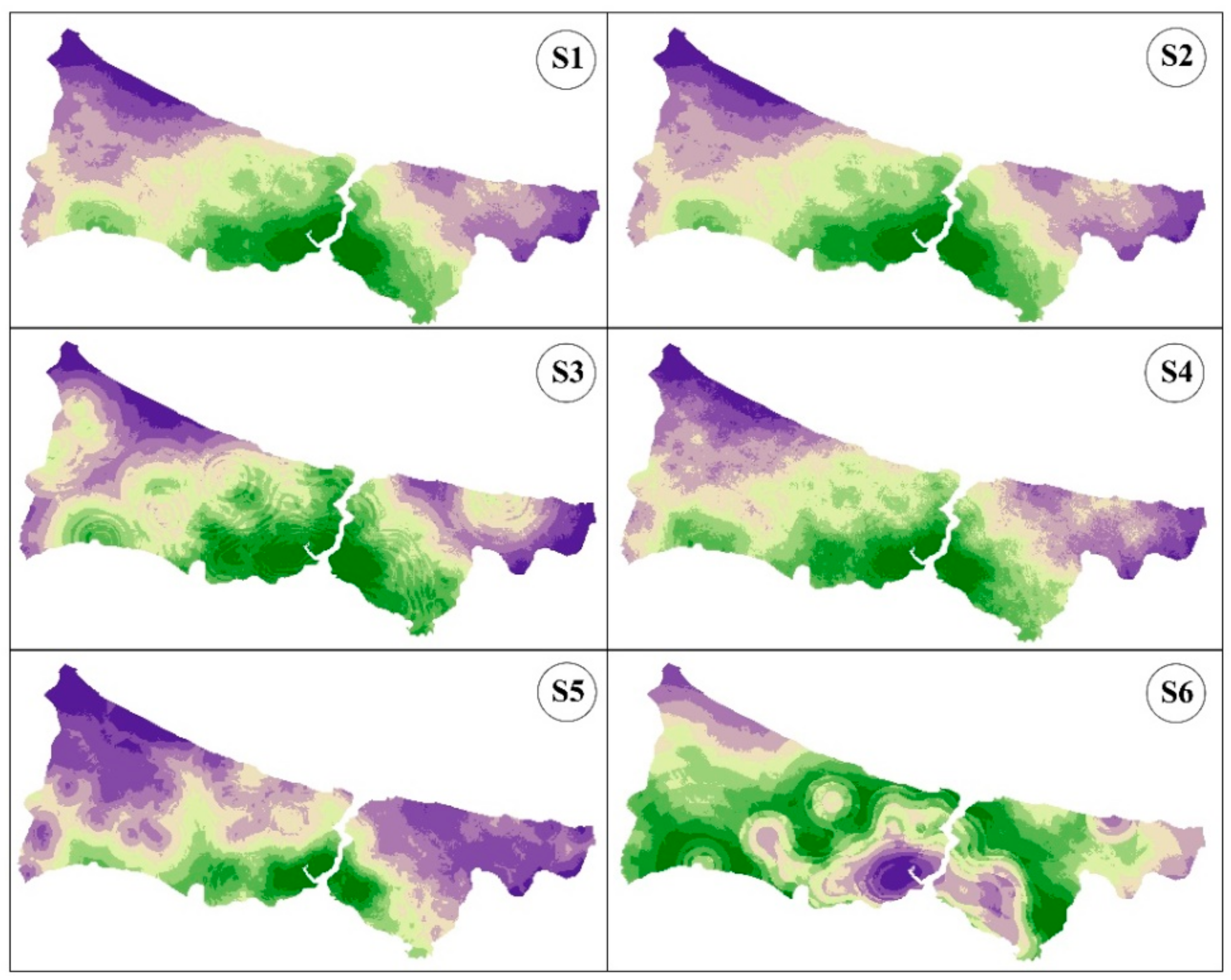
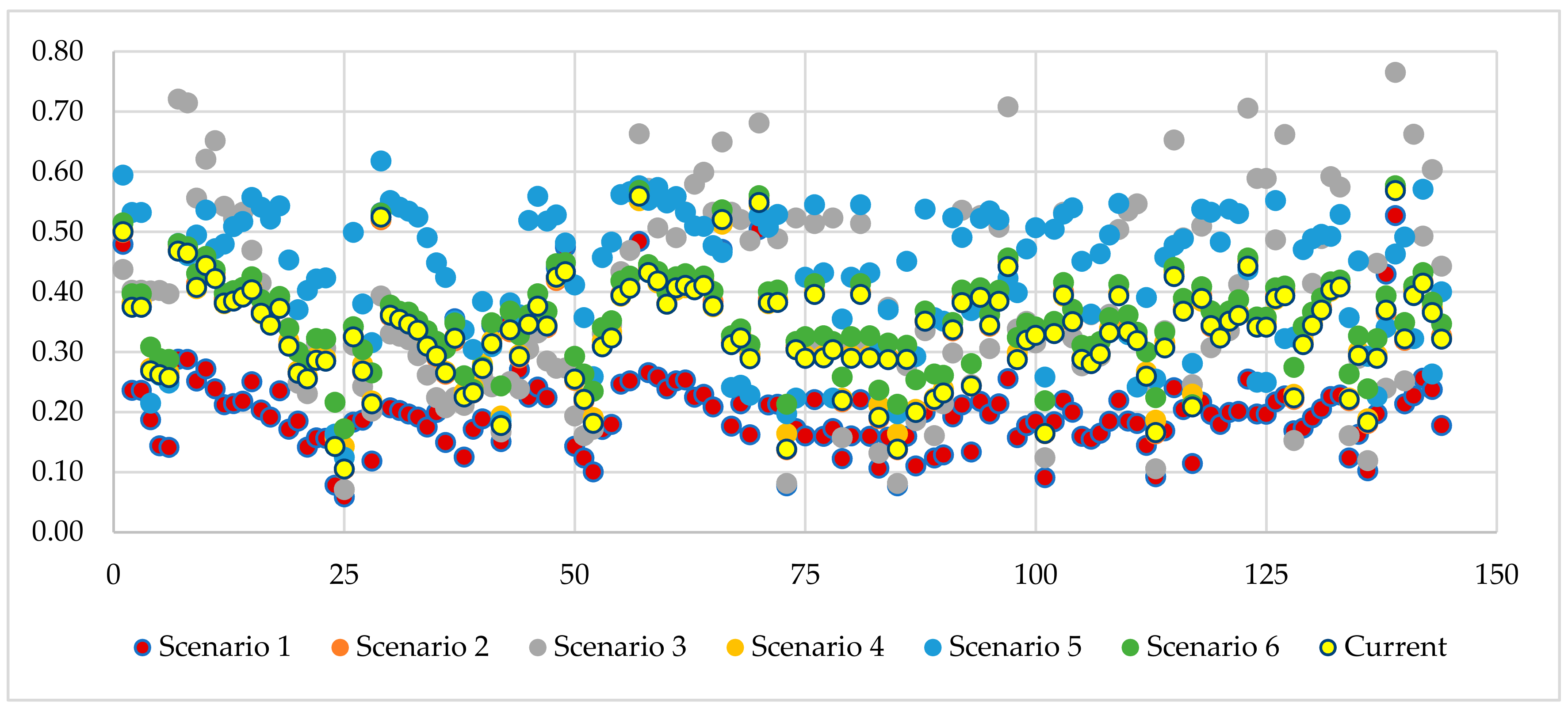

| Study Area | N Sub-Criteria | Applied Methods | EVCS Location | Ref. |
|---|---|---|---|---|
| Beijing | 15 | ANP-PROMETHEE | General locations analysis | [26] |
| Tianfu | 14 | Entropy-ELECTRE | The most suitable locations considering 6/30 alternatives | [27] |
| Valencia | 5 | Genetic Algorithm-Multi Agent Systems | Estimation of the best configurations | [28] |
| Tianjin | 13 | Fuzzy Grey Relation Analysis-Fuzzy VIKOR-Entropy | Empirical study of five alternatives locations | [29] |
| Chengdu | a | Dynamic Clustering-Barycentric Method | Managing the location of the e-taxi charging station | [30] |
| Empirically | b | Robust Optimisation Algorithm-Queuing Theory | Optimisation of location reducing construction costs and the number of EVCSs. | [31] |
| Beijing | 14 | Fuzzy AHP-Grey Relational Projection (GRP)-Picture Fuzzy Weighted Interaction Geometric (PFWIG) | Optimisation and selection of suitable location. | [32] |
| Seoul | c | Maximum Set Covering Model | Optimisation of location using data for one week. | [33] |
| Beijing | 11 | Fuzzy TOPSIS | Optimisation of location considering four alternative EVCSs. | [34] |
| Tehran | 10 | Bayesian Network | Optimisation of location considering four alternative EVCSs. | [35] |
| Beijing | d | Mathematical Models | Comparative analysis considering the actual 40 public charging stations. | [36] |
| İstanbul | 9 | WASPAS-TOPSIS | A simple approach model is proposed to evaluate four car-sharing stations. | [37] |
| Cost per KWh (EUR) | Cost per Charge (EUR) | Cost per 10 Miles (EUR) | Cost per 100 Miles (EUR) | |
|---|---|---|---|---|
| Turkey | 0.075 | 7.48 | 0.18 | 1.85 |
| US | 0.137 | 13.69 | 0.34 | 3.38 |
| UK | 0.149 | 14.87 | 0.37 | 3.67 |
| Italy | 0.141 | 14.11 | 0.34 | 3.49 |
| Australia | 0.171 | 17.14 | 0.42 | 4.23 |
| Japan | 0.199 | 19.91 | 0.50 | 4.91 |
| Main Criteria | Sub-Criteria | Descriptions | References | |
|---|---|---|---|---|
| Properties of Station | C1.1 | Service Capacity | Status and number of available sockets at stations. This situation affects the service capacity of the station. | |
| C1.2 | Charge Power | Charging time, speed at stations, and fast charging status. This affects the service performance of the stations, as electric vehicles will be produced with the fast-charging option. | ||
| Energy/Power | C2.1 | Electrical Substation | Distance and proximity to substations. Proximity to the electrical substation is effective in meeting the energy demand of the stations. | [19,26,29,50] |
| C2.2 | Source of Renewable Energy | Influence of operating costs. Siting the stations in regions where the availability of renewable energy resources is important in terms of operating costs. | [30,33,51] | |
| Environmental/Urbanity | C3.1 | Population Size | E-vehicle ownership and e-mobility demand. The population size is linked to electric vehicle ownership. | [26,29,32,34,52] |
| C3.2 | Social and Public Areas | Potential e-mobility demand and habits. Considering that, people often spend time in these areas; the potential demand for charging is high in related areas. | [30,50] | |
| C3.3 | Tourism Region | Attractiveness of the area. It affects EVCS locations due to the charging time of electric vehicles and the travel situation to these areas. | [53,54,55,56] | |
| C3.4 | Service Centre | Timeliness of the maintenance service. To provide uninterrupted service at the stations, rapid intervention is required in case of malfunction or maintenance. | ||
| C3.5 | Environmental Pollution | Environmental damage caused by energy consumption. Electric vehicles should be disseminated and encouraged in regions with high emission values. | [35] | |
| Physiographic | C4.1 | Woodland | Protection of green area. To protect green areas, regions far from these regions should be preferred where EVCS is located. | [19,27,32,34] |
| C4.2 | Aquatic Resources | Water resources protection. To protect water resources, regions far from these regions should be preferred where EVCS is located. | [19,27,35] | |
| C4.3 | Slope of Land | Plano-altimetrico development of the infrastructure Considering the operating and construction costs, areas where the slope percentage is low should be preferred for EVCS sitting. | [19] | |
| Financially | C5.1 | Income Rate | The income level of people influences the ownership. Electric vehicle ownership is generally concentrated in high-income regions. | |
| C5.2 | Motor Vehicles | It is suitable for the e-mobility trend. It is predicted that the rate of electrification will be high in regions where the number of conventional motor vehicles is high. | [30] | |
| C5.3 | E-Vehicles | It influences transport demand/supply. The need for charging is high in areas where electric vehicles are intense. | [27,29] | |
| Transportation | C6.1 | Road Networks | Operation efficiency of EVCSs close to road networks will be high. | [19,30,33,57,58] |
| C6.2 | Intersection Area | Operational efficiency and accessibility. | [17,55] | |
| C6.3 | Parking Spaces | Parking lot and garages in the service area. When the charging time is considered in the suitable siting of EVCSs, the parking spaces used intensively by the vehicles affect the EVCS locations. | [56,57,59,60,61] | |
| C1 | C2 | C3 | C4 | C5 | C6 | ||||||
|---|---|---|---|---|---|---|---|---|---|---|---|
| Properties of Stations | Energy/Power | Environmental/Urbanity | Physiographic | Financially | Transportation | ||||||
| C1.1 | 0.0829 | C2.1 | 0.0219 | C3.1 | 0.0726 | C4.1 | 0.0313 | C5.1 | 0.0357 | C6.1 | 0.0507 |
| C1.2 | 0.0792 | C2.2 | 0.0215 | C3.2 | 0.0765 | C4.2 | 0.0288 | C5.2 | 0.0469 | C6.2 | 0.0409 |
| C3.3 | 0.0168 | C4.3 | 0.0193 | C5.3 | 0.1215 | C6.3 | 0.1280 | ||||
| C3.4 | 0.0145 | ||||||||||
| C3.5 | 0.1108 | ||||||||||
| Total | 0.1621 | 0.0435 | 0.2912 | 0.0794 | 0.2041 | 0.2196 | |||||
| The top 20 in first class | EVCS | G23 | E45 | SV0 | Z48 | E55 | Z0 | Z18 | Z19 | Z21 | SV105 |
| 0.5687 | 0.5593 | 0.5486 | 0.5246 | 0.5205 | 0.5002 | 0.4680 | 0.4645 | 0.4437 | 0.4427 | ||
| EVCS | SV51 | E18 | E46 | S90 | E17 | Z22 | E47 | G35 | E51 | E53 | |
| 0.4419 | 0.4335 | 0.4322 | 0.4256 | 0.4242 | 0.4223 | 0.4182 | 0.4143 | 0.4109 | 0.4109 | ||
| The top 20 in second class | EVCS | SV32 | G16 | G43 | E49 | Sv78 | E39 | Z31 | SV58 | SV92 | G27 |
| 0.5031 | 0.4693 | 0.4592 | 0.4367 | 0.4330 | 0.4320 | 0.4181 | 0.4065 | 0.4016 | 0.4012 | ||
| EVCS | Z46 | Z30 | Z15 | Z12 | SV82 | SV47 | Z47 | E66 | Z35 | SV38 | |
| 0.3907 | 0.3860 | 0.3841 | 0.3680 | 0.3674 | 0.3672 | 0.3532 | 0.3399 | 0.3335 | 0.3328 | ||
| The bottom 20 in first class | EVCS | SV40 | E2 | G2 | SV37 | G10 | E20 | SV15 | Z45 | SV93 | SV28 |
| 0.2316 | 0.2251 | 0.2238 | 0.2211 | 0.2211 | 0.2211 | 0.2192 | 0.2139 | 0.2088 | 0.1996 | ||
| EVCS | SV20 | G14 | E40 | E10 | SV86 | SV62 | Z39 | SV3 | SV23 | Z41 | |
| 0.1914 | 0.1832 | 0.1816 | 0.1777 | 0.1658 | 0.1646 | 0.1428 | 0.1385 | 0.1385 | 0.1054 | ||
| The bottom 20 in second class | EVCS | E33 | G15 | Z60 | Z42 | E59 | E60 | G12 | E63 | E64 | E22 |
| 0.2522 | 0.2489 | 0.2435 | 0.2373 | 0.2323 | 0.2229 | 0.2213 | 0.2206 | 0.2206 | 0.2172 | ||
| EVCS | Z13 | SV52 | Z63 | SV29 | G13 | E23 | G25 | SV94 | Z61 | G40 | |
| 0.2122 | 0.2109 | 0.2092 | 0.2031 | 0.2026 | 0.2019 | 0.1993 | 0.1860 | 0.1664 | 0.1378 |
| third class | Rank | 1 | 2 | 3 | 4 | 5 | 6 | 7 | 8 | 9 | 10 | 11 | 12 | 13 |
| EVCS | G42 | G7 | S113 | Z64 | Z69 | Z62 | Z59 | Z11 | E6 | Z65 | SV79 | SV108 | E25 | |
| 0.5161 | 0.4367 | 0.4320 | 0.4181 | 0.3907 | 0.3860 | 0.3841 | 0.3680 | 0.3532 | 0.3335 | 0.3326 | 0.3311 | 0.3208 | ||
| Rank | 14 | 15 | 16 | 17 | 18 | 19 | 20 | 21 | 22 | 23 | 24 | 25 | 26 | |
| EVCS | G32 | G31 | SV99 | SV112 | Z10 | Z67 | E28 | Z66 | SV84 | E32 | SV57 | E7 | Z68 | |
| 0.3145 | 0.3143 | 0.3135 | 0.3100 | 0.3076 | 0.2958 | 0.2689 | 0.2649 | 0.2602 | 0.2560 | 0.2522 | 0.2435 | 0.2373 | ||
| Rank | 27 | 28 | 29 | 30 | 31 | 32 | 33 | 34 | 35 | |||||
| EVCS | G20 | G29 | G33 | G41 | SV24 | Z58 | E24 | SV55 | E8 | |||||
| 0.2323 | 0.2229 | 0.2206 | 0.2206 | 0.2172 | 0.2122 | 0.2092 | 0.2019 | 0.1664 | ||||||
| fourth class | Rank | 1 | 2 | 3 | 4 | 5 | 6 | 7 | 8 | 9 | 10 | 11 | 12 | 13 |
| EVCS | G22 | SV22 | G26 | E29 | E5 | G21 | SV71 | G1 | SV61 | SV83 | SV87 | G28 | Z8 | |
| 0.5113 | 0.4821 | 0.3312 | 0.3132 | 0.2804 | 0.2662 | 0.2479 | 0.2290 | 0.2289 | 0.2278 | 0.2113 | 0.2086 | 0.1983 | ||
| Rank | 14 | 15 | 16 | 17 | 18 | 19 | 20 | |||||||
| EVCS | SV95 | G8 | Z5 | SV39 | E26 | E27 | G0 | |||||||
| 0.1943 | 0.1918 | 0.1868 | 0.1784 | 0.1595 | 0.1515 | 0.1443 | ||||||||
| fifth class | Rank | 1 | 2 | 3 | 4 | 5 | 6 | 7 | 8 | 9 | 10 | 11 | 12 | 13 |
| EVCS | E30 | E31 | G3 | SV100 | SV107 | SV26 | SV27 | SV4 | SV5 | SV81 | Z6 | Z7 | Z9 | |
| 0.8591 | 0.8649 | 0.0911 | 0.1853 | 0.0910 | 0.1026 | 0.1040 | 0.1026 | 0.1040 | 0.0939 | 0.0749 | 0.1168 | 0.1025 | ||
| sixth class | Rank | 1 | 2 | 3 | 4 | 5 | ||||||||
| EVCS | E27 | Z8 | Z5 | E5 | E26 | |||||||||
| 0.8063 | 0.2791 | 0.2552 | 0.2155 | 0.1339 |
Publisher’s Note: MDPI stays neutral with regard to jurisdictional claims in published maps and institutional affiliations. |
© 2021 by the authors. Licensee MDPI, Basel, Switzerland. This article is an open access article distributed under the terms and conditions of the Creative Commons Attribution (CC BY) license (https://creativecommons.org/licenses/by/4.0/).
Share and Cite
Kaya, Ö.; Alemdar, K.D.; Campisi, T.; Tortum, A.; Çodur, M.K. The Development of Decarbonisation Strategies: A Three-Step Methodology for the Suitable Analysis of Current EVCS Locations Applied to Istanbul, Turkey. Energies 2021, 14, 2756. https://doi.org/10.3390/en14102756
Kaya Ö, Alemdar KD, Campisi T, Tortum A, Çodur MK. The Development of Decarbonisation Strategies: A Three-Step Methodology for the Suitable Analysis of Current EVCS Locations Applied to Istanbul, Turkey. Energies. 2021; 14(10):2756. https://doi.org/10.3390/en14102756
Chicago/Turabian StyleKaya, Ömer, Kadir Diler Alemdar, Tiziana Campisi, Ahmet Tortum, and Merve Kayaci Çodur. 2021. "The Development of Decarbonisation Strategies: A Three-Step Methodology for the Suitable Analysis of Current EVCS Locations Applied to Istanbul, Turkey" Energies 14, no. 10: 2756. https://doi.org/10.3390/en14102756
APA StyleKaya, Ö., Alemdar, K. D., Campisi, T., Tortum, A., & Çodur, M. K. (2021). The Development of Decarbonisation Strategies: A Three-Step Methodology for the Suitable Analysis of Current EVCS Locations Applied to Istanbul, Turkey. Energies, 14(10), 2756. https://doi.org/10.3390/en14102756









